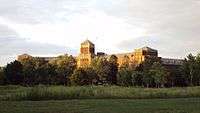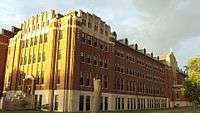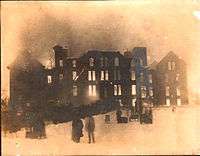Sisters, Servants of the Immaculate Heart of Mary
 | |
| Established | 1845 |
|---|---|
| President | Sister Mary Jane Herb 2012–present |
| Residents | 200 |
| Staff | 245 |
| Location |
610 West Elm Avenue |
| Website | Official website |
The Sisters, Servants of the Immaculate Heart of Mary (I.H.M.) is a Catholic religious institute of sisters. It is divided among three separate congregations. The original community of the institute is headquartered in Monroe, Michigan. The Motherhouse currently houses more than 200 sisters, more than 100 of whom require supportive care. The sisters originally began as teachers, but their ministries have become more diverse, including: Education in grade schools, high schools, colleges and universities, pastoral care in hospitals, long-term care facilities and other health care settings, parish ministry and outreach into poor communities, social services for poor and homeless families, working with those with AIDS, individuals in need, they provide spiritual direction and retreats, advocacy efforts to help people get the resources needed to fully participate in society, programs and services for older adults in a variety of settings, and the sisters work to improve the environment.
History


The beginnings of the institute came about in 1845 shortly after Father Louis Florent Gillet, C.Ss.R., arrived in Monroe, Michigan to become the pastor of St. Mary Parish. On November 10, Gillet and Theresa Maxis Duchemin, a member of the Oblate Sisters of Providence in Baltimore, established the institute in Monroe.[1]
Father Gillet found that Monroe had no school for the daughters of the descendants of French Canadians, most of whom were Catholic. Father Gillet petitioned the local bishop, Peter Paul Lefevere, Bishop of Detroit, for a religious institute to assume teaching duties. The bishop declined, so Father Gillet invited three women to form a new religious congregation, which would become known as the Sisters, Servants of the Immaculate Heart of Mary.
The co-foundress and first religious superior of the Monroe community was Mother Theresa Maxis Duchemin, one of the first members of Oblate Sisters of Providence, the first religious congregation established in the country for women of African descent. On January 15, 1846, the first St. Mary Academy opened with 40 students.
In 1858, a mission was established to serve the German-speaking Catholic children of Pennsylvania at the request of the Bishop of Philadelphia, the now-sainted John Neumann.[2] As a result of this mission, a dispute broke out between the bishops of Detroit and Philadelphia regarding their jurisdiction over the Sisters. Mother Theresa was faulted by Bishop Lefevre for this and was removed from her office of Superior General. She was then sent to the mission in Pennsylvania. Shortly after this, in 1859, the Sisters in that state separated from the community in Michigan and were established as an independent congregation under the Bishop of Philadelphia.
This congregation later further split into two more, one based in Scranton, Pennsylvania (founded in 1871[2]), and the other in Chester County, Pennsylvania.
In 1920, St. Mary Academy and College had outgrown its facilities and the institute made plans to construct a new college facility. The Sisters initially planned to build the new campus in Monroe, but Bishop Michael Gallagher invited them to build in nearby Detroit. In Detroit the college would have a larger field of influence and offer a Catholic higher education to thousands of young women who might otherwise not have such an opportunity. The Sisters built their new college in Detroit and named it Marygrove College.

On June 3, 1929, St. Mary Academy in Monroe was destroyed by fire. This caused extreme difficulties for the IHM institute, as they were burdened with heavy debts from the building of Marygrove College and the cost of rebuilding the motherhouse and academy in Monroe was prohibitive. Additionally, the Great Depression of 1929 began soon afterward, which only added to their financial woes. Nevertheless, the institute finished the reconstruction and moved into their new facilities in 1932. The congregation went on to establish Marian and Immaculata High Schools in the Detroit area and Immaculate Heart of Mary High School in Westchester, Illinois.
In 1948, the Michigan congregation began its first missionary work outside the continental United States when the Sisters opened a mission in Cayey, Puerto Rico.
In 2008, the Sisters opened Detroit Cristo Rey High School and co-sponsor it with the Congregation of St. Basil.[3]
Educational Institutions
Schools
- Detroit Cristo Rey High School, Detroit, Michigan (co-sponsored)
- Our Lady of Guadalupe Middle School, Detroit, Michigan (co-sponsored)
- Our Lady of Lourdes Academy, Miami, Florida
- Villa Maria Academy, Immaculata (Lower School) & Malvern (high school), Pennsylvania
- Colegio Villa Maria Miraflores, Lima, Perú
- Colegio Villa Maria La Planicie, Lima, Peru
- Villa Maria Academy (founded in 1940), Santiago de Chile, Chile
- Marian High School, Bloomfield Hills, Michigan
- Defunct
- Girls Catholic Central High School, Detroit, Michigan
- Hall of the Divine Child, Monroe, Michigan
- Immaculata High School, Detroit, Michigan
- Immaculate Heart of Mary High School, Westchester, Illinois (absorbed by St. Joseph High)
- St. Mary's Academy, Monroe, Michigan (merged with Monroe Catholic Central High to form St. Mary Catholic Central High School)
- Colegio San Antonio, Bellavista, Perú (founded on 1928)
Colleges & Universities
- Immaculata University, near Philadelphia, Pennsylvania
- Marygrove College, Detroit, Michigan
- Marywood University, Scranton, Pennsylvania
In the arts
In 2012, the Monroe campus was used for filming numerous scenes of Arnaud Desplechin's movie Jimmy P: Psychotherapy of a Plains Indian (2013), which were to be in competition at the 2013 Cannes Film Festival, figuring the now vanished Winter Veteran Hospital of Topeka, Kansas.[4]
References
- ↑ "Our Co-Founders: Louis Florent Gillet and Theresa Maxis" Accessed June 2, 2010.
- 1 2 "IHM: History" Accessed October 11, 2010.
- ↑ "About Detroit Cristo Rey High School" Accessed June 2, 2010.
- ↑ (English) ‘AKA Jimmy Picard’, starring Benicio Del Toro, begins filming in Monroe, Michigan on www.onlocationvacations.com 2012-06-19.
